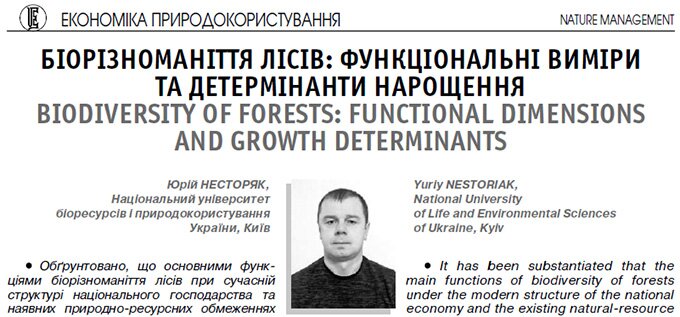|
|
|||
|
|||
 БІОРІЗНОМАНІТТЯ ЛІСІВ: ФУНКЦІОНАЛЬНІ ВИМІРИ ТА ДЕТЕРМІНАНТИ НАРОЩЕННЯ BIODIVERSITY OF FORESTS: FUNCTIONAL DIMENSIONS AND GROWTH DETERMINANTS Юрій НЕСТОРЯК, Національний університет біоресурсів і природокористування України, Київ Yuriy NESTORIAK, National University of Life and Environmental Sciences of Ukraine, Kyiv Обґрунтовано, що основними функціями біорізноманіття лісів при сучасній структурі національного господарства та наявних природно-ресурсних обмеженнях є: асиміляційна, стабілізаційно-захисна, відновлювально-відтворювальна, рекреаційна, естетично-культурна, ресурсно-сировинна, соціально-економічна та міжгосподарська. Встановлено, що головними детермінантами відтворення та збереження біорізноманіття лісів екзогенного спрямування є такі: впровадження у практику ведення лісового господарства пріоритетів Спільної аграрної політики ЄС; виконання взятих Україною зобов’язань у рамках підписаних резолюцій міністерств і конференцій щодо захисту лісів у Європі; зміцнення стійкості лісових екосистем внаслідок умонтування в діяльність постійних лісокористувачів природозберігаючих технологій у лісівництві; імплементація міжнародних природоохоронних директив ЄС стосовно збереження водно-болотних угідь. Доведено, що основними детермінантами збереження, відтворення та примноження біорізноманіття лісів ендогенного спрямування виступають: забезпечення безперервного та невиснажливого ведення лісового господарства на ренатуралізованих осушених сільськогосподарських угіддях; збільшення площі земель природно-заповідного фонду за рахунок земель сільськогосподарського призначення, де пройшли незворотні ренатуралізаційні процеси; розширення спектра інституціональних форм стосовно створення захисних лісових смуг; застосування в системі менеджменту постійних лісокористувачів сучасної методології оцінки ефективності господарського освоєння біорізноманіття лісів. It has been substantiated that the main functions of biodiversity of forests under the modern structure of the national economy and the existing natural-resource constraints are: assimilatory, stabilizationprotective, restoration-reproductive, recreational, aesthetic-cultural, resource-raw, socio-economic and inter-farm ones. It has been established that the main determinants of reproduction and preservation of exogenous forest biodiversity are as follows: implementation of the priorities of the Common Agricultural Policy of the EU in the practice of forestry management; fulfilment of commitments undertaken by Ukraine in the framework of signed resolutions of ministries and conferences on protection of forests in Europe; strengthening the sustainability of forest ecosystems as a result of the setting of permanent forest users of nature-conservation technologies in forestry; implementation of the EU’s international environmental directives on the conservation of wetlands. It has been proven that the main determinants of conservation, reproduction and multiplication of endogenous forest biodiversity are as follows: ensuring the continuous and inexhaustible management of forestry on the renaturalized drained agricultural lands; increase of the area of the lands of the natural reserve fund at the expense of agricultural land, where irreversible renaturalization processes took place; expansion of institutional forms regarding the creation of protective forest strips; application in the system of management of constant forest users of modern methodology for assessing the effectiveness of economic development of forest biodiversity. Повний текст статті
|
Найбільш популярні матеріали
-
1251Віталій Чудовець: Після закінчення спеціальності «Облік і оподаткування» ніколи не виникне необхідності отримувати іншу освіту
-
310Вадим Новинський визначився
-
220В Україні зменшується споживання металу
-
163Зростання промвиробництва від початку року становить 0,9%
-
145Глобальний ВВП збільшиться за підсумками поточного року на 2,7%






